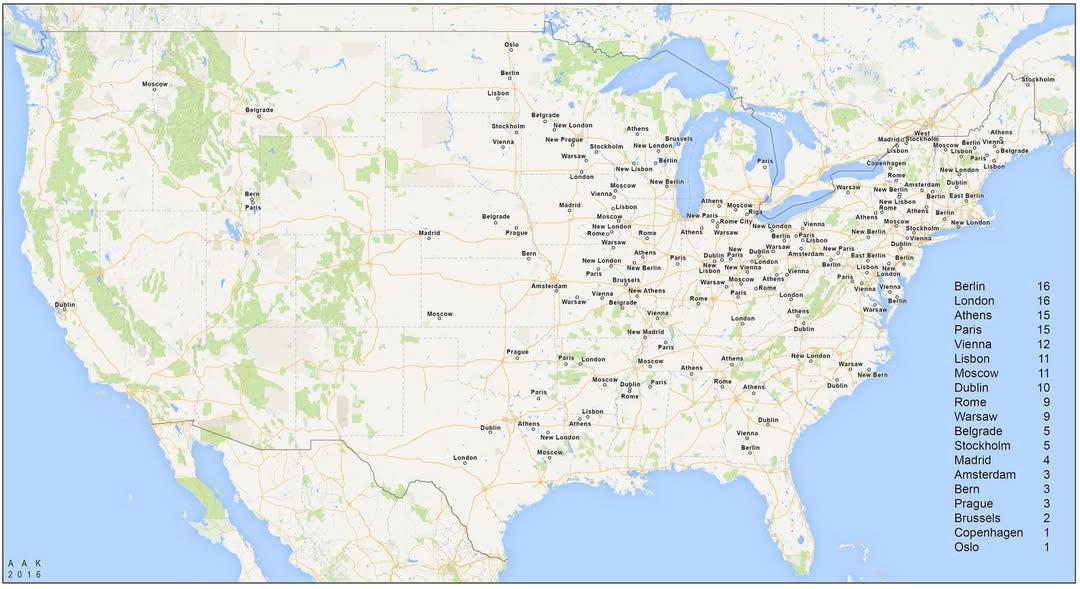U.S. Towns and Cities Named After European Capitals Map


Alex Cartwright
Senior Cartographer & GIS Specialist
Alex Cartwright is a renowned cartographer and geographic information systems specialist with over 15 years of experience in spatial analysis and data...
Geographic Analysis
What This Map Shows
The visualization titled "U.S. Towns and Cities Named After European Capitals Map" presents a unique geographical perspective on American urban naming conventions. It highlights various towns and cities across the United States that bear names of European capitals. From Vienna, Virginia, to Athens, Georgia, this map illustrates the fascinating connections between American place names and their European counterparts. It's not just a collection of names; it’s a reflection of historical ties, migration patterns, and cultural influences that have shaped the American landscape.
Deep Dive into American Naming Conventions
The practice of naming places after European capitals is not just a quirky coincidence; it is deeply rooted in America's history. The 18th and 19th centuries were marked by significant European immigration, bringing a wave of cultural influences that permeated various aspects of American life, including geography. Cities with names reflecting European capitals often emerged during periods of settlement, when immigrants sought to recreate their homeland in their new environment.
Interestingly, many towns named after European capitals retain a rich cultural heritage. For example, Paris, Texas, was founded in 1844 and has often highlighted its connection to the City of Light through local festivals and cultural events. Similarly, Dublin, Ohio, named after the Irish capital, reflects the large Irish-American population that settled there. Such naming practices serve as a reminder of the deep-rooted connections between the U.S. and Europe, emphasizing how geography can encapsulate history.
Have you ever wondered why certain towns have names that seem out of place? Take Berlin, Wisconsin, for example. The name was inspired by the German capital, showcasing the influence of German immigrants who settled in the area. This pattern is evident across the map, showcasing a blend of cultures, languages, and histories that contribute to the American identity.
Moreover, the naming of towns can also reveal socio-political contexts. During the 19th century, as the U.S. expanded westward, settlers often named new towns after familiar places to create a sense of home. This practice not only offered comfort to immigrants but also helped establish a sense of identity in these burgeoning communities. The names became cultural anchors, making the unfamiliar landscape feel a little more like home.
Regional Analysis
When diving into the regional distribution of these towns and cities, we can see intriguing patterns emerge. The Northeast, with its historical ties to early European settlers, features numerous cities named after European capitals. For instance, the town of Paris, Maine, and the city of Vienna, New Jersey, highlight this trend. These areas often had significant populations of immigrants from specific European countries, leading to names that reflect that heritage.
Conversely, in the Midwest, cities like Warsaw, Indiana, and Dublin, Ohio, signify the settlement patterns of Eastern European and Irish immigrants respectively. The Midwest often served as a landing point for waves of immigrants in the 19th century, and the naming of towns often reflected the nationalities of the settlers. Furthermore, the West Coast has its own unique examples, such as Athens, California, which showcases the influence of Greek immigrants.
Interestingly, the South also contributes to this diverse tapestry with cities like Madrid, Alabama, and Florence, Alabama, drawing on European names while also embodying local characteristics. Each region tells a story of migration, adaptation, and cultural blending that has shaped the American landscape.
Significance and Impact
Understanding the significance of towns and cities named after European capitals goes beyond mere geography. It connects us to the historical narratives of immigration, cultural exchange, and the creation of American identity. As globalization continues to influence our world, these place names serve as a reminder of our interconnectedness with Europe and the broader world.
Moreover, these names often carry implications for cultural tourism. Cities like Athens, Georgia, and Vienna, Virginia, attract visitors who are curious about their namesakes and the cultural heritage they embody. This trend can foster a sense of pride among residents and encourages the preservation of local history.
Looking to the future, as the U.S. continues to evolve demographically, we may see an increase in place names reflecting an even broader range of cultures and influences, especially from Latin America, Asia, and Africa. The map of U.S. towns and cities named after European capitals is not just a reflection of the past; it is also a lens through which we can view the future of American geographical identity.
In conclusion, this map is a fascinating representation of how our geographical landscape is shaped by history, culture, and the movement of people. The towns and cities named after European capitals are not just locations on a map, but rather, they are stories waiting to be told, each with its own unique connection to the rich tapestry of American history.
Visualization Details
- Published
- October 18, 2025
- Views
- 34
Comments
Loading comments...